History of paleontology

| Part of a series on |
| Paleontology |
|---|
 |
|
Paleontology Portal Category |
The history of paleontology traces the history of the effort to understand the history of life on Earth by studying the fossil record left behind by living organisms. Since it is concerned with understanding living organisms of the past, paleontology can be considered to be a field of biology, but its historical development has been closely tied to geology and the effort to understand the history of Earth itself.
In ancient times,
In
In 1822, the word "paleontology" was used by the editor of a French scientific journal to refer to the study of ancient living organisms through fossils, and the first half of the 19th century saw geological and paleontological activity become increasingly well organized with the growth of geologic societies and museums and an increasing number of professional geologists and fossil specialists. This contributed to a rapid increase in knowledge about the history of life on Earth, and progress towards definition of the geologic time scale largely based on fossil evidence. As knowledge of life's history continued to improve, it became increasingly obvious that there had been some kind of successive order to the development of life. This would encourage early evolutionary theories on the transmutation of species.[3] After Charles Darwin published On the Origin of Species in 1859, much of the focus of paleontology shifted to understanding evolutionary paths, including human evolution, and evolutionary theory.[3]
The last half of the 19th century saw a tremendous expansion in paleontological activity, especially in North America.
Prior to the 17th century
As early as the 6th century BC, the
In 1027, the
As a result of a new emphasis on observing, classifying, and cataloging nature, 16th-century natural philosophers in Europe began to establish extensive
However, most 16th-century Europeans did not recognize that
Leonardo da Vinci and the development of paleontology
The hills around Parma and Piacenza show abundant mollusks and bored corals still attached to the rocks. When I was working on the great horse in Milan, certain peasants brought me a huge bagful of them
— Leicester Code, folio 9r
Such fossil borings allowed Leonardo to confute the Inorganic theory, i.e. the idea that so-called petrified shells (mollusk body fossils) are inorganic curiosities. With the words of Leonardo da Vinci:[20][14]
[the Inorganic theory is not true] because there remains the trace of the [animal's] movements on the shell which [it] consumed in the same manner of a woodworm in wood ...
— Leicester Code, folio 9v
Da Vinci discussed not only fossil borings, but also burrows. Leonardo used fossil burrows as paleoenvironmental tools to demonstrate the marine nature of sedimentary strata:[19]
Between one layer and the other there remain traces of the worms that crept between them when they had not yet dried. All the sea mud still contains shells, and the shells are petrified together with the mud
— Leicester Code, folio 10v
Other Renaissance naturalists studied invertebrate ichnofossils during the Renaissance, but none of them reached such accurate conclusions.[21] Leonardo's considerations of invertebrate ichnofossils are extraordinarily modern not only when compared to those of his contemporaries, but also to interpretations in later times. In fact, during the 1800s invertebrate ichnofossils were explained as fucoids, or seaweed, and their true nature was widely understood only by the early 1900s.[22][23][24] For these reasons, Leonardo da Vinci is deservedly considered the founding father of both the major branches of palaeontology, i.e. the study of body fossils and ichnology.[14]
17th century
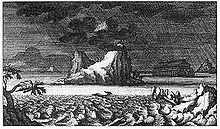
During the Age of Reason, fundamental changes in natural philosophy were reflected in the analysis of fossils. In 1665 Athanasius Kircher attributed giant bones to extinct races of giant humans in his Mundus subterraneus. In the same year Robert Hooke published Micrographia, an illustrated collection of his observations with a microscope. One of these observations was entitled "Of Petrify'd wood, and other Petrify'd bodies", which included a comparison between petrified and ordinary wood. He concluded that petrified wood was ordinary wood that had been soaked with "water impregnated with stony and earthy particles". He then suggested that several kinds of fossil sea shells were formed from ordinary shells by a similar process. He argued against the prevalent view that such objects were "Stones form'd by some extraordinary Plastick virtue latent in the Earth itself".[25] Hooke believed that fossils provided evidence about the history of life on Earth writing in 1668:
...if the finding of Coines, Medals, Urnes, and other Monuments of famous persons, or Towns, or Utensils, be admitted for unquestionable Proofs, that such Persons or things have, in former times had a being, certainly those Petrifactions may be allowed to be of equal Validity and Evidence, that there have formerly been such Vegetables or Animals... and are true universal Characters legible to all rational Men.[26]
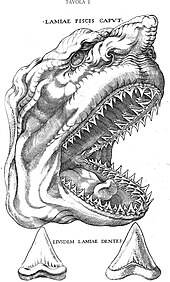
Hooke was prepared to accept the possibility that some such fossils represented species that had become extinct, possibly in past geological catastrophes.[26]
In 1667
Despite the considerable influence of Forerunner, naturalists such as
18th century
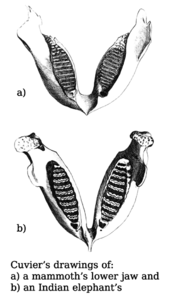
In his 1778 work Epochs of Nature
In 1796
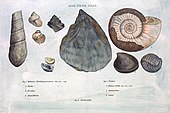
In a pioneering application of
Early to mid-19th century
The study of fossils and the origin of the word paleontology

The
In 1828
The age of mammals
In 1804, Cuvier identified two fossil mammal genera from the gypsum quarries of the outskirts of Paris (known as the
In 1812, Cuvier followed up with published drawn reconstructions on known remains of "Palaeotherium" minor (= Plagiolophus minor), "Anoplotherium medium" (= Xiphodon gracilis), and, most famously, Anoplotherium commune. In A. commune, he was able to predict accurately that A. commune had robust muscles in its entire body to support its short limbs and long tail. He also described hypothesized paleobiologies of the different species assigned to Anoplotherium (some of which would eventually be assigned to different Paleogene artiodactyls such as Xiphodon and Dichobune). His skeletal reconstructions of fossil mammal genera and hypothesis of paleoecological behaviors are considered among the earliest instances within paleontology.[36][44] He also drew muscle reconstructions of A. commune based on known skeletal remains of the species, which were reprinted but never published to the public out of his concern that they were too speculative. Today, however, his muscle reconstructions of A. commune are seen as accurate and having paved the way for paleoart and biomechanics.[45]
The age of reptiles
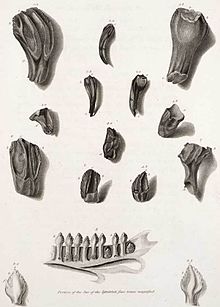
In 1808, Cuvier identified a fossil found in
In 1824, Buckland found and described a lower jaw from
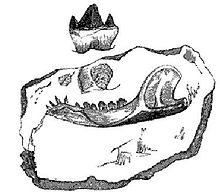
This evidence that giant reptiles had lived on Earth in the past caused great excitement in scientific circles,
Catastrophism, uniformitarianism and the fossil record
In Cuvier's landmark 1796 paper on living and fossil elephants, he referred to a single catastrophe that destroyed life to be replaced by the current forms. As a result of his studies of extinct mammals, he realized that animals such as Palaeotherium and Anoplotherium had lived before the time of the mammoths, which led him to write in terms of multiple geological catastrophes that had wiped out a series of successive faunas.[55] By 1830, a scientific consensus had formed around his ideas as a result of paleobotany and the dinosaur and marine reptile discoveries in Britain.[56] In Great Britain, where natural theology was very influential in the early 19th century, a group of geologists that included Buckland, and Robert Jameson insisted on explicitly linking the most recent of Cuvier's catastrophes to the biblical flood. Catastrophism had a religious overtone in Britain that was absent elsewhere.[57]
Partly in response to what he saw as unsound and unscientific speculations by
Transmutation of species and the fossil record
In the early 19th century
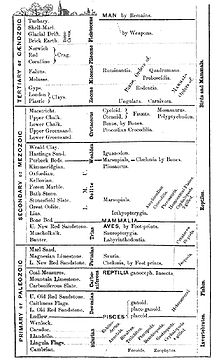
Geological time scale and the history of life
Geologists such as Adam Sedgwick, and Roderick Murchison continued, in the course of disputes such as The Great Devonian Controversy, to make advances in stratigraphy. They described newly recognized geological periods, such as the Cambrian, the Silurian, the Devonian, and the Permian. Increasingly, such progress in stratigraphy depended on the opinions of experts with specialized knowledge of particular types of fossils such as William Lonsdale (fossil corals), and John Lindley (fossil plants) who both played a role in the Devonian controversy and its resolution.[69] By the early 1840s much of the geologic time scale had been developed. In 1841, John Phillips formally divided the geologic column into three major eras, the Paleozoic, Mesozoic, and Cenozoic, based on sharp breaks in the fossil record.[70] He identified the three periods of the Mesozoic era and all the periods of the Paleozoic era except the Ordovician. His definition of the geological time scale is still used today.[71] It remained a relative time scale with no method of assigning any of the periods' absolute dates. It was understood that not only had there been an "age of reptiles" preceding the current "age of mammals", but there had been a time (during the Cambrian and the Silurian) when life had been restricted to the sea, and a time (prior to the Devonian) when invertebrates had been the largest and most complex forms of animal life.
Expansion and professionalization of geology and paleontology
This rapid progress in geology and paleontology during the 1830s and 1840s was aided by a growing international network of geologists and fossil specialists whose work was organized and reviewed by an increasing number of geological societies. Many of these geologists and paleontologists were now paid professionals working for universities, museums and government geological surveys. The relatively high level of public support for the earth sciences was due to their cultural impact, and their proven economic value in helping to exploit mineral resources such as coal.[72]
Another important factor was the development in the late 18th and early 19th centuries of museums with large natural history collections. These museums received specimens from collectors around the world and served as centers for the study of comparative anatomy and
Late 19th century
Evolution

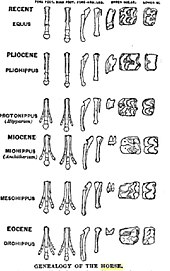
There was also great interest in human evolution. Neanderthal fossils were discovered in 1856, but at the time it was not clear that they represented a different species from modern humans. Eugene Dubois created a sensation with his discovery of Java Man, the first fossil evidence of a species that seemed clearly intermediate between humans and apes, in 1891.[78]
Developments in North America
A major development in the second half of the 19th century was a rapid expansion of paleontology in North America. In 1858
Overview of developments in the 20th century
Developments in geology
Two 20th-century developments in geology had a big effect on paleontology. The first was the development of
Geographical expansion of paleontology
During the 20th century, paleontological exploration intensified everywhere and ceased to be a largely European and North American activity. In the 135 years between Buckland's first discovery and 1969 a total of 170 dinosaur genera were described. In the 25 years after 1969 that number increased to 315. Much of this increase was due to the examination of new rock exposures, particularly in previously little-explored areas in South America and Africa.[81] Near the end of the 20th century, the opening of China to systematic exploration for fossils has yielded a wealth of material on dinosaurs and the origin of birds and mammals.[82] Also study of the Chengjiang fauna, a Cambrian fossil site in China, during the 1990s has provided important clues to the origin of vertebrates.[83]
Mass extinctions
The 20th century saw a major renewal of interest in
Evolutionary paths and theory
Throughout the 20th century new fossil finds continued to contribute to understanding the paths taken by evolution. Examples include major taxonomic transitions such as finds in Greenland, starting in the 1930s (with more major finds in the 1980s), of fossils illustrating the evolution of
The results of paleontology have also contributed to the development of evolutionary theory. In 1944 George Gaylord Simpson published Tempo and Mode in Evolution, which used quantitative analysis to show that the fossil record was consistent with the branching, non-directional, patterns predicted by the advocates of evolution driven by natural selection and genetic drift rather than the linear trends predicted by earlier advocates of neo-Lamarckism and orthogenesis. This integrated paleontology into the modern evolutionary synthesis.[86] In 1972 Niles Eldredge and Stephen Jay Gould used fossil evidence to advocate the theory of punctuated equilibrium, which maintains that evolution is characterized by long periods of relative stasis and much shorter periods of relatively rapid change.[87]
Cambrian explosion
One area of paleontology that has seen a lot of activity during the 1980s, 1990s, and beyond is the study of the
Pre-Cambrian fossils

Prior to 1950 there was no widely accepted fossil evidence of life before the Cambrian period. When
See also
- History of biology
- History of evolutionary thought
- History of geology
- History of science
- List of fossil sites (with link directory)
- List of years in paleontology
- Taxonomy of commonly fossilised invertebrates
- Timeline of paleontology
- Treatise on Invertebrate Paleontology
- History of paleontology in the United States
Notes
- ^ Dong 1992
- ^ a b c Garwood, Russell J. (2012). "Life as a palaeontologist: Palaeontology for dummies, Part 2". Palaeontology Online. 4 (2): 1–1o. Retrieved July 29, 2015.
- ^ ISBN 978-0-405-12706-9.
- ^ Prothero, D (2008-02-27). "Evolution: What missing link?". New Scientist. No. 2645. pp. 35–40.
- ^ Bowler Evolution: The History of an Idea pp. 351–352
- ^ Desmond pp. 692–697.
- ^ Rudwick The Meaning of Fossils p. 39
- ^ Rudwick The Meaning of Fossils p. 24
- ^ Shen Kuo,Mengxi Bitan (梦溪笔谈; Dream Pool Essays) (1088)
- ^ Needham, Volume 3, p. 614.
- ^ Rudwick The Meaning of Fossils pp. 9–17
- ^ Rudwick The Meaning of Fossils pp. 23–33
- ^ Rudwick The Meaning of Fossils pp. 33–36
- ^ S2CID 86011122.
- ISBN 9780444538147.)
{{cite book}}: CS1 maint: multiple names: authors list (link - ^ Rudwick, M.J.S., 1976, The Meaning of Fossils: Episodes in the History of Palaeontology: University of Chicago Press, Chicago, 308 p.
- INHIGEO, Festina Lente, Firenze, pp. 13–26
- ^ VAI, G.B., 2003, I viaggi di Leonardo lungo le valli romagnole: Riflessi di geologia nei quadri, disegni e codici, in Perdetti, C., ed., Leonardo, Macchiavelli, Cesare Borgia (1500–1503): Arte Storia e Scienza in Romagna: De Luca Editori d’Arte, Rome, pp. 37–48
- ^ a b Baucon, A. 2010. Da Vinci’s Paleodictyon: the fractal beauty of traces. Acta Geologica Polonica, 60(1). Available from the author's homepage
- ^ Baucon, A. 2008. Italy, the Cradle of Ichnology: the legacy of Aldrovandi and Leonardo. In: Avanzini M., Petti F. Italian Ichnology, Studi Trent. Sci. Nat. Acta Geol., 83. Paper available from the author's homepage
- ^ Baucon A. 2009. Ulisse Aldrovandi: the study of trace fossils during the Renaissance. Ichnos 16(4). Abstract available from the author's homepage
- ^ Osgood, R.G., 1975, The history of invertebrate ichnology, in Frey, R.W., ed., The Study of Trace Fossils: Springer Verlag, New York, pp. 3–12.
- ^ Osgood, R.G., 1970, Trace fossils of the Cincinnati area: Paleontographica Americana, v. 6, no. 41, pp. 281–444.
- ^ Pemberton, S.G., MacEachern, J.A., and Gingras, M.K., 2007, The antecedents of invertebrate ichnology in North America: The Canadian and Cincinnati schools, in Miller, W., III, ed., Trace Fossils. Concepts, Problems, Prospects: Elsevier, Amsterdam, pp. 14–31.
- ^ Hooke Micrographia observation XVII
- ^ a b Bowler The Earth Encompassed (1992) pp. 118–119
- ^ Rudwick The Meaning of Fossils pp. 72–73
- ^ Rudwick The Meaning of Fossils pp. 61–65
- ^ Bowler The Earth Encompassed (1992) p. 117
- ^ McGowan the dragon seekers pp. 3–4
- ^ Georges Cuvier, Recherches sur les ossements fossiles de quadrupèdes, 1812, Paris ("First edition of a work which laid the foundation to vertebrate paleontology")
- ^ Henri Marie Ducrotay de Blainville, "Analyse des principaux travaux dans les sciences physiques, publiés dans l'année 1821", Journal de phyique, tome XCIV, p. 54
- ^ Rudwick Worlds before Adam p. 48
- ^ Rudwick The Meaning of Fossils pp. 145–147
- ^ Bowler The Earth Encompassed (1992)
- ^ a b Cuvier, Geoges (1812). "Résumé général et rétablissement des Squelettes des diverses espèces". Recherches sur les ossemens fossiles de quadrupèdes: où l'on rétablit les caractères de plusieurs espèces d'animaux que les révolutions du globe paroissent avoir détruites (in French). Vol. 3. Chez Deterville.
- ^ Dor, M. (1938). "Sur la biologie de l'Anoplotherium (L'Anoplotherium était-il aquatique?)". Mammalia. 2: 43–48.
- .
- ^ Cuvier, Georges (1804). "Suite des Recherches: Sur les espèces d'animaux dont proviennent les os fossiles répandus dans la pierre à plâtre des environs de Paris". Annales du Muséum National d'Histoire Naturelle, Paris (in French). 3: 364–387.
- S2CID 246893918.
- ^ Belhoste, Bruno (2017). "Chapter 10: From Quarry to Paper. Cuvier's Three Epistemological Cultures". In Chemla, Karine; Keller, Evelyn Fox (eds.). Cultures without Culturalism: The Making of Scientific Knowledge. Duke University Press. pp. 250–277.
- ^ Cuvier, Georges (1807). "Suite des recherches sur les os fossiles des environs de Paris. Troisième mémoire, troisième section, les phalanges. Quatrième mémoire sur les os des extrémités, première section, les os longs des extrémités postérieures". Annales du Muséum d'Histoire Naturelle. 9: 10–44.
- ^ Cuvier, Georges (1807). "Suite des recherches sur les os fossiles des environs de Paris. Ve mémoire, IIe section, description de deux skelettes presque entiers d'Anoplotherium commune". Annales du Muséum d'Histoire Naturelle (in French). 9: 272–282.
- ^ Rudwick, Martin J. S. (1997). "Chapter 6: The Animals from the Gypsum Beds around Paris". Georges Cuvier, Fossil Bones, and Geological Catastrophes: New Translations and Interpretations of the Primary Texts. University of Chicago Press.
- ^ Witton, Mark P.; Michel, Ellinor (2022). "Chapter 4: The sculptures: mammals". The Art and Science of the Crystal Palace Dinosaurs. The Crowood Press. pp. 68–91.
- ^ Rudwick Georges Cuvier, Fossil Bones and Geological Catastrophes p. 158
- ^ McGowan pp. 11–27
- ^ Rudwick, Martin Worlds Before Adam: The Reconstruction of Geohistory in the Age of Reform (2008) pp. 154–155.
- ^ "Mary Anning: the unsung hero of fossil discovery". www.nhm.ac.uk. Retrieved 2022-01-16.
- ^ Cadbury, Deborah The Dinosaur Hunters (2000) pp. 171–175.
- ^ McGowan p. 176
- ^ McGowan pp. 70–87
- ^ McGowan p. 109
- ^ McGowan pp. 78–79
- ^ Rudwick The Meaning of Fossils pp. 124–125
- ^ Rudwick The Meaning of Fossils pp. 156–157
- ^ Rudwick The Meaning of Fossils pp. 133–136
- ^ McGowan pp. 93–95
- ^ a b McGowan pp. 100–103
- ^ Rudwick The Meaning of Fossils pp. 178–184
- ^ McGowan pp. 100
- ^ Rudwick The Meaning of Fossils p. 119
- ^ McGowan p. 8
- ^ McGowan pp. 188–191
- ^ Larson p. 73
- ^ Larson p. 44
- ^ Ruckwick The Meaning of fossils pp. 206–207
- ^ Larson p. 51
- ^ Rudwick The Great Devonian Controversy p. 94
- ^ Larson pp. 36–37
- ^ Rudwick The Meaning of Fossils p. 213
- ^ Rudwick The Meaning of Fossils pp. 200–201
- ^ Greene and Depew The Philosophy of Biology pp. 128–130
- ^ Bowler and Morus Making Modern Science pp. 168–169
- ^ Bowler Evolution: The History of an Idea p. 150
- ^ Larson Evolution p. 139
- ^ Larson pp. 126–127
- ^ Larson pp. 145–147
- ^ Everhart Oceans of Kansas p. 17
- ^ The Bone Wars. From Wyoming Tales and Trails Wyoming Tales and Trails.
- ^ McGowan p. 105
- ^ Bowler Evolution p. 349
- ^ Prothero ch. 8
- S2CID 16017767.)
{{cite journal}}: CS1 maint: multiple names: authors list (link - ^ Garwin, Laura; Tim Lincoln. "A Century of Nature: Twenty-One Discoveries that Changed Science and the World". University of Chicago Press. pp. 3–9. Retrieved 2009-07-19.
- ^ Bowler Evolution p. 337
- ^ Eldredge, Niles and S. J. Gould (1972). "Punctuated equilibria: an alternative to phyletic gradualism" In T.J.M. Schopf, ed., Models in Paleobiology. San Francisco: Freeman Cooper. pp. 82–115. Reprinted in N. Eldredge Time frames. Princeton: Princeton Univ. Press, 1985. Available here "Niles Eldredge Library of Evolution". Archived from the original on 2009-04-22. Retrieved 2009-07-20..
- S2CID 44066226.
- PMID 10860955.
References
- ISBN 978-0-520-23693-6.
- ISBN 978-0-393-32080-0.
- Bowler, Peter J.; Iwan Rhys Morus (2005). Making Modern Science. The University of Chicago Press. ISBN 978-0-226-06861-9.
- Desmond, Adrian (1975). "The Discovery of Marine Transgressions and the Explanation of Fossils in Antiquity". American Journal of Science, Volume 275.
- ISBN 978-0-679-64288-6.
- McGowan, Christopher (2001). The Dragon Seekers. Persus Publishing. ISBN 978-0-7382-0282-2.
- Everhart, Michael J. (2005). Oceans of Kansas: A Natural History of the Western Interior Sea. Indiana University Press. ISBN 978-0-253-34547-9.
- Greene, Marjorie; David Depew (2004). The Philosophy of Biology: An Episodic History. Cambridge University Press. ISBN 978-0-521-64371-9.
- ISBN 978-0-253-34547-9.
- Robert Hooke (1665) Micrographia The Royal Society
- Palmer, Douglas (2005) Earth Time: Exploring the Deep Past from Victorian England to the Grand Canyon. Wiley, Chichester. ISBN 978-0-470-02221-4
- ISBN 978-0-226-73106-3.
- ISBN 978-0-231-53942-5.
- ISBN 978-0-226-73103-2.
- ISBN 978-0-226-73102-5.
- ISBN 978-0-226-73128-5.
- Zittel, Karl Alfred von (1901). History of geology and palaentology to the end of the Nineteenth Century. Charles Scribner's Sons, London.
- OCLC 26522845.
External links

